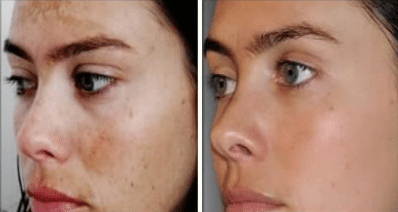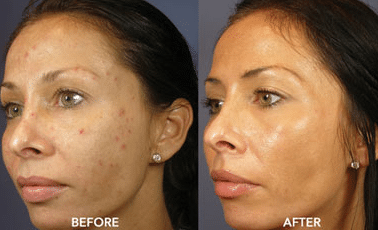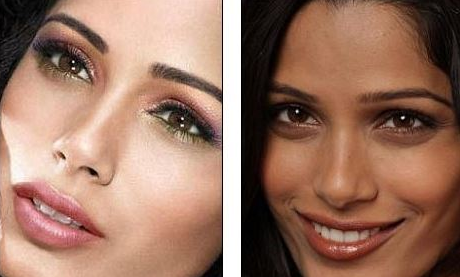What are the hydroquinone side effects? Get more insights on the hydroquinone products, whitening cream in relation to skin cancer and the associated side effects.

hydroquinone before and after skin
Hydroquinone Effectiveness
Over the past many years, hydroquinone is a known controversial skin-care product or ingredient used for topical use. What is known for sure is that hydroquinone is a strong inhibitor of dark pigmentation called melanin production and for over about 50 years has, it has been established as the most effective ingredient for reducing and potentially doing away with brown skin discolorations on the skin often known to as melasma.
In different brands and concentrations hydroquinone strongly inhibits or prevents the skin from making that enzyme responsible for production of melanin, the required pigment that provides the skin with its color.
Over-the-counter hydroquinone product can only have about 0.5% to 2% concentrations, with 2% being the highest and most effective over the counter amount. At the pharmacy however, 4% concentrations of hydroquinone (and sometimes even higher amount) are found strictly by prescription only. A concentration of about 12% hydroquinone fully prevents the production of melanin altogether.
What is confusing to the buyer is the exaggerated indication that is possible for negative side effects from the use of hydroquinone products. Yet a clearer observation at the research shows problematic skin reactions that are rare and, more often than not, very minor. The most startling risk is a skin disorder known as ochronosis that is a bluing discoloration of the skin.
Though that’s scary indication, it’s important to keep in mind and remember that with millions of gallons of hydroquinone used for about over the past like 50 years, only a few of ochronosis cases have been directly linked to the use of hydroquinone. What’s more is that the cases have been a result of long term use of the product at high concentrations, or of using hydroquinone products that have been mixed with dangerous ingredients.
Hydroquinone made products were banned in the USA years ago where the most severe problems happened. But, hydroquinone products in USA and other several countries were found to also have mercury and glucocorticoids that are among other caustic and illegal contaminants that is also believed by many to be the cause and the reason of the serious side effects seen.
Countries that are part of the European Union have since banned hydroquinone mainly on the basis of these reports. This ban is frustrating to most people as when properly formulated, hydroquinone is not as a harmful ingredient and there’s no substantiated research indicating otherwise.
Ironically, plant extracts like Mitracarpus scaber or madder extract, Uva ursi or bearberry extract, mulberry, white mulberry, and paper mulberry is touted as being the optional natural skin lightening agents that actually break down into hydroquinone when absorbed into skin, which indicates why they have a positive effect. Another natural option is arbutin which also, as you guessed, it breaks down into hydroquinone in body skin.
Whether or not you consider the usage of hydroquinone in a skin-care product is of course up to a personal decision. What is very clear is that hydroquinone is a well-studied ingredient, incredibly effective for its intended purpose, and that no other skin lightening ingredient can be compared to its level of effectiveness.
One critical point to keep in mind is that hydroquinone can turn a strange shade of brown with a prolonged, daily exposure to air or even sunlight. When you are considering an option of a hydroquinone product, it is important to be sure it is packaged in a non-transparent container that doesn’t let light in and that reduces the amount of exposure to air.
Hydroquinone products that are packaged in jars are at all not recommended as once opened they very quickly become ineffective or likely to causes some of the alleged hydroquinone side effects.
For other available options applied for skin lightening—though with very less research or impressive and such consistent improvement are niacinamide, licorice extract (specifically the one known as glabridin), and stabilized forms of vitamin C (especially L-ascorbic acid or ascorbic acid, and ascorbyl phosphate can also be considered as options.
There is also no research indicating exactly how much of each ingredient is required to achieve desired results so you that have to trust in the cosmetic company making the claims, and we all know how reliable the information is.
Still, some companies, like Procter & Gamble (P&G, owner of brands like Olay) are coming up with an impressive body of study concerning skin lightening ingredients that rival the effectiveness of hydroquinone without considering hydroquinone side effects.
Hydroquinone is specifically used in lightening of the dark patches of the skin (also reffered to as hyperpigmentation, melasma, liver spots and freckles) that is caused by pregnancy, birth control pills, hormone medicine, or injury happening to the skin.
This medicine strictly works by blocking the process in the skin that leads to production of melanin.
How to use Hydroquinone Skin Bleaching topical

before and after hydroquinone
Follow keenly every directions on the product package or apply as directed by the doctor. Before using this product, apply a very small amount of this medicine to an area of unbroken skin like the back of the hand palm and check the area in 24 hours for any serious side effects that might occur.
If the test area feels itchy, red, or blistering, do not apply this product and contact the doctor. If there is just a mild redness, then the treatment using this product may start.
Use this medication specifically to the affected areas of the body skin, usually twice daily or as directed by the doctor. This medication is for application on the skin only. If the medication is used incorrectly, unwanted skin lightening of the product may occur.
Avoid to get this product in the eyes or on the inside of the nose or mouth. If you do get accidentally this medication in those mentioned areas, flush with a lot of water.
This medication may however make the treated areas of skin to become more sensitive to the sun. Avoid as much as possible prolonged sun exposure, the tanning booths, and even sunlamps. Apply a sunscreen and wear protective clothing on the treated areas of skin especially when outdoors.
Use the medication regularly to get the most benefit from the hydroquinone. To help you remember, use it at the same times each day.
Inform the doctor if the condition persists or worsens after a period of 2 months.
In medical studies, hydroquinone is taken as the primary skin topical ingredient for inhibiting production of the melanin. Its components have a known potent antioxidant abilities.
Topical hydroquinone is available in 2% (found in cosmetics) to 4% (or even more) concentrations that is available from a physician or by prescription, alone or also in combination with tretinoin which is about 0.05% to 0.1%. Research has indicated hydroquinone and tretinoin that prevents sun or hormone-induced melasma.
Hydroquinone is a very strong inhibitor of production of melanin, implying that it inhibits dark skin from making the substance that is responsible for skin color. Hydroquinone do not bleach the skin but actually lightens it, and can only disrupt the synthesis and production of melanin hyperpigmentation. It has been banned in most European countries like France due to fears of a cancer risk.
A few concerns on hydroquinone’s safety on the skin have been indicated, but the study when it comes to topical application of the medication shows negative reactions are small or a result of using very high concentrations or from all other skin-lightening agents like the glucocorticoids or even mercury iodine. Any known risk is also likely applicable for most African women.
Hydroquinone has been indicated to cause leukemia in mice as well as other animals. The European Union thus banned the medication from cosmetics in early 2001, but it indicates up in bootleg creams available in the developing world. It is sold also in the United States only as an over-the-counter drug, but with a concentration of the hydroquinone content not exceeding 2 percent.
Due to hydroquinone’s action mostly on the skin, it can be also be an irritant, especially in higher concentrations of 4% or greater and predictably when combined with other products like tretinion. Some other medications have been made to combine 4% hydroquinone with tretinoin and a form of cortisone. The cortisone is also included as an anti-inflammatory.
The negative side effect of the repeated application of the cortisone is only countered by the positive effect that is brought about by the tretinoin so that it does not cause any thinning of skin and thus damaging to collagen. Safer alternatives are very expensive but are found.
Hydroquinone is a chemical compound that has been used for several years as an addition in skin care products. One molecule of hydroquinone has two hydroxyl compounds including the compound benzene.
At normal room temperature in its raw state, this chemical hydroquinone has a very lustrous white color and is comprised of long and thin crystals. While hydroquinone is the most common name that is used for the chemical, it is also known as Quilon or benzene-1, 4-diol.
The production of hydroquinone is done via one of the three common methods. Each of these methods involves a combination of another substance, usually phenol or benzene that has at least one other chemical. The combination of these chemicals causes a reaction to happen and hydroquinone to be formed together with at least one other by-product.
When producing several skin care products formulations, manufacturers apply varied concentrations of hydroquinone. The concentration is represented by a given percentage and refers to how much of the volume of the product consists of hydroquinone.
At times, the body will suddenly start to involve in production of excessive levels of melanin in one given area, causing that particular region of skin to look darker than the other tissue. Usually, this sudden increase in dark pigmentation levels is due to sun overexposure.
When the discoloration comes as random blotches on the skin complexion, it is also known as age spots, while the smaller dots of darkening that are commonly referred to as freckles. During pregnancy stages and other times when a woman’s hormones vary widely, a form of skin discoloration called melasma or chloasma can happen too.
With skin application, hydroquinone performs very locally on the skin to bring down the amount of melanin in the area to which it was applied. As a result, the discoloration slowly fades away. Some doctors and medical researchers believe that the effectiveness that is linked to hydroquinone is from the fact that it greatly interferes with a chemical that is responsible for starting the production of melanin in the skin cells.
Hydroquinone has the ability to cause uncomfortable side effects that includes redness, itching and swelling. Due to this, many people are not able to use hydroquinone or must opt for milder options formulations that has the ingredient. Products that has hydroquinone are not very recommended for use by either pregnant or even nursing mothers.
Best Hydroquinone Cream
This is a topical medication and as any other medication there are several side effects that occurs at different levels. It could be as a natural or synthetic enzyme tyrosinase inhibitor. For sure it works as expected and thus no more copper on the skin, the problem is the side effects when the treated skin is exposed to the UV-rays
Products with Hydroquinone
People may have heard about the skin bleaching and skin lightening chemical compound known as hydroquinone. But do they know what it really is, how the compound works and whether it is safe to use on your skin?
Hydroquinone is used in several skin lightening products but most people are still not aware if there are any risks associated with the use of any of these products. But the truth is that there are hydroquinone side effects
Non Hydroquinone Skin Lighteners
Some skin lighteners’ products makers are now applying the use of safer and more natural alternatives. So it is now very possible to get skin lightening creams that do not have hydroquinone.
The main alternative ingredient used is arbutin that has kojic acid also being used in some products
Hydroquinone Side Effects
A person may experience mild burning, a stinging, redness, and even dryness may happen as hydroquinone side effects. If any of these effects continues or worsens, tell the doctor or pharmacist immediately.
If the doctor has already prescribed the medication, always remember that he or she has observed and tested the skin you have that the benefit is thus greater than the risk of side effects. Many people who use this medication may not have very serious side effects.
Stop use of this product and tell the doctor immediately if any of the unlikely but serious side effects happens like blistering, skin cracking or blue-black darkening of the body skin.
A very serious allergic reaction to this drug is not common as hydroquinone side effects. But, seek immediate medical attention from the doctor if you notice any of the symptoms of a serious allergic reaction that includes a rash, itching or swelling (especially occurring on the face or tongue or throat), severe dizziness and even troubled breathing.
This is not a full list of possible side effects. If you notice other effects other than the ones listed above, contact the doctor or pharmacist immediately.
Hydroquinone Cream Side Effects
Since the year 2006 when the FDA released an official statement saying that it was reviewing its previous approval of the hydroquinone side effects chemical, several concerns have mounted about whether or not the ingredient is safe for use.
One issue being researched on is if hydroquinone side effects has the potential to cause cancer because it contains the toxin benzene.
Another side effect being investigated is exogenous ochronosis, which is a condition where the skin is able to develop black spots.
While it has been already established that ingesting hydroquinone through this method can lead to this problem, medical doctors are thus unsure to whether or not there is a similar risk that is associated with topical use of the ingredient. As of June the year 2012, the FDA has yet to release its final ruling on hydroquinone side effects.














